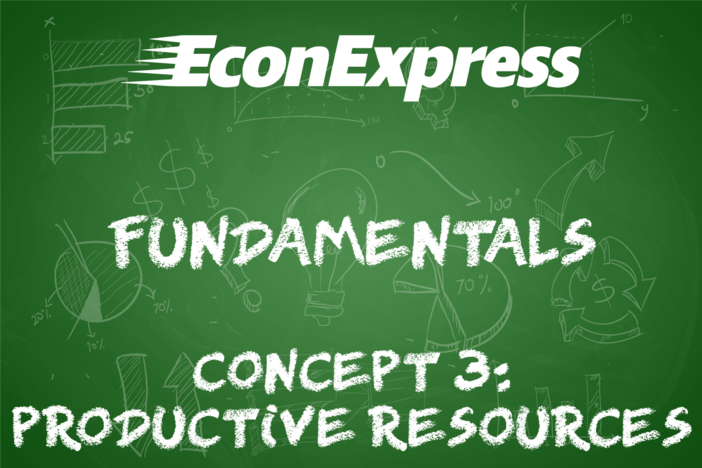Concept 3: Productive Resources
Overview: All goods and services require resources. In this concept you will learn what these resources are and get practice identifying them.
Learn
Beginner

All goods and services are produced using productive resources (also known as factors of production). These resources are divided into four broad categories: natural (land), human (labor), capital and entrepreneurship.
- Natural resources are “gifts” of nature and include things like raw materials, water, wood, air, sunlight, soil, animals, etc.
- Human resources refers to the mental and physical skills of people involved in the production process.
- Capital resources are the man-made tools, factories, machinery and chemicals used to produce final goods and services.
- Entrepreneurs are people who develop ways to combine the other productive resources to produce goods and services. They take financial risks to bring these goods and services to market. Entrepreneurship is a unique resource that is further explained in Concept 4 – Entrepreneurship.
Money is NOT a productive resource. Money is used to purchase productive resources.
Intermediate

Some natural resources are renewable like forests or fruits and vegetables while others are non-renewable like fossil fuels or natural gas. Both are scarce, however, since they are limited, desirable and have multiple uses.
Human resources are unique because they can often be improved through training, education or experience. In 2018, it is estimated that companies in the United States spent about $87 billion on training and professional development programs. Improvements to human resources are often referred to as human capital.
Capital resources are sometimes tricky to identify because one firm’s product may be a capital resource for another firm. For example, hardware stores sell hammers as a final product. For a construction company, however, a hammer is a capital resource. Financial capital is not the same as capital resources. Financial capital generally refers to money needed to acquire natural, human, and capital resources and pay entrepreneurs.
Advanced

The money used to acquire each productive resource has a specific name that it sometimes used for accounting purposes.
- Rent is the term generally used for money that goes towards natural resources.
- Wages describes the money used to procure human resources.
- Interest is the term used to describe the payment for capital goods.
- Profit describes the money paid to entrepreneurs, the reward for their risk-taking.
The sum of all payments to resources – wages, rents, interest and profits – is national income, or the “income approach” to calculating a nation’s gross domestic product.
Click a reading level below or scroll down to practice this concept.
Practice
Assess
Below are five questions about this concept. Choose the one best answer for each question and be sure to read the feedback given. Click “next question” to move on when ready.
Social Studies 2024
Define and give examples of productive resources (i.e. factors of production): natural resources (i.e. land), human resources (i.e. labor and human capital), physical capital and entrepreneurship.














